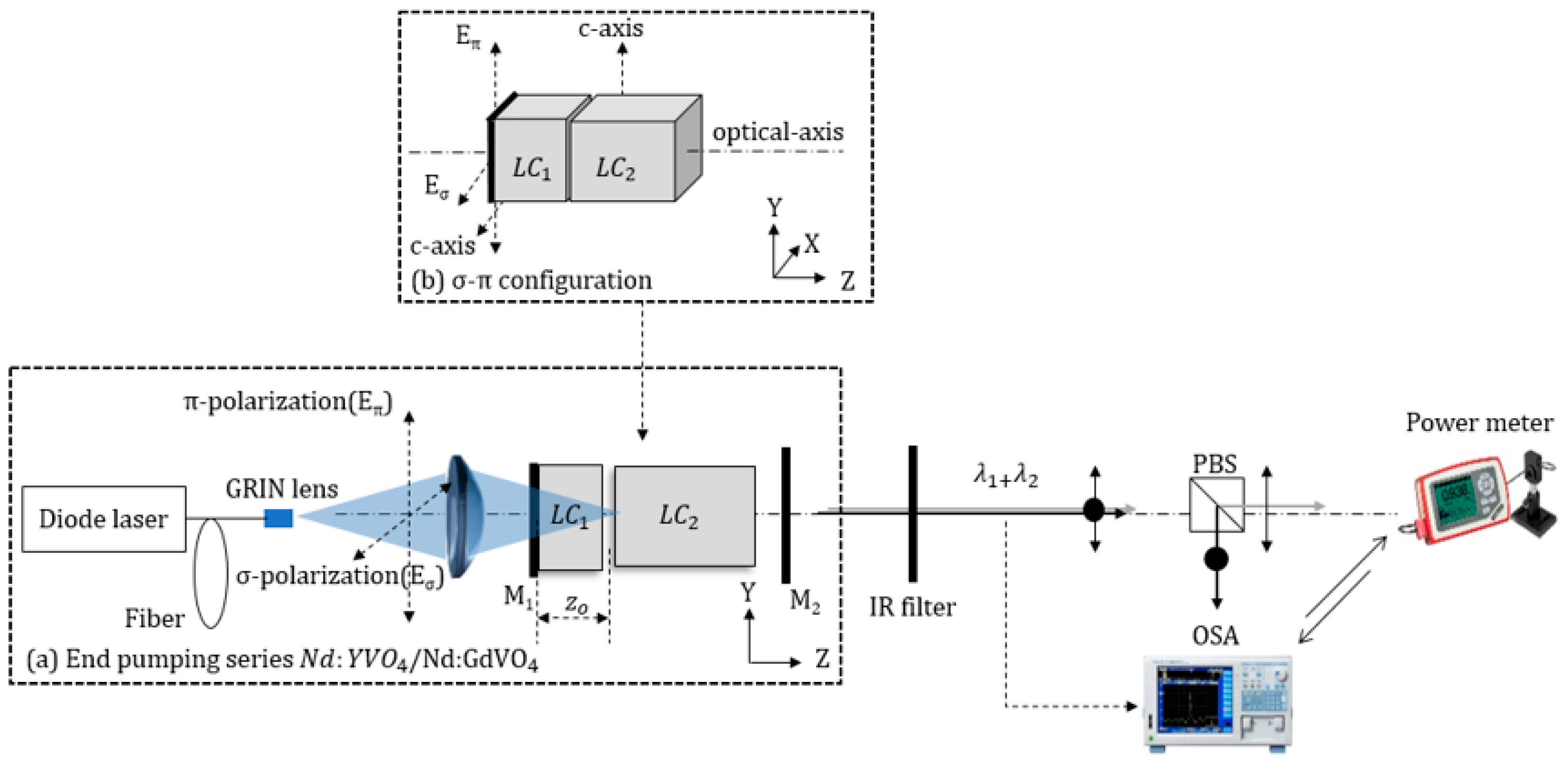Efficient Dual-Wavelengths Continuous Mode Lasers by End-Pumping of Series Nd:YVO4 and Nd:GdVO4 Crystals and Speckle Reduction Study
Abstract
:1. Introduction
2. Experiments
2.1. Dual-Wavelength Laser Setup
2.2. Tri/Quad Wavelength Laser Setup
2.3. The Speckle Contrast Imaging Configuration
3. Results and Discussions
3.1. Dual Output Wavelengths
3.2. Tri and Quad Output Wavelengths Emission
4. Conclusions
Author Contributions
Funding
Conflicts of Interest
References
- Liu, Y.; Zhong, K.; Mei, J.; Wang, M.; Guo, S.; Liu, C.; Xu, D.; Shi, W.; Yao, J. Compact and flexible dual-wavelength laser generation in coaxial diode-end-pumped configuration. IEEE Photonics J. 2017, 9, 1–10. [Google Scholar] [CrossRef]
- Ding, Y.J. Progress in terahertz sources based on difference-frequency generation. J. Opt. Soc. Am. B 2014, 31, 2696–2711. [Google Scholar] [CrossRef]
- Liu, Y.; Zhong, K.; Mei, J.; Liu, C.; Shi, J.; Ding, X.; Xu, D.; Shi, W.; Yao, J. Compact and stable high-repetition-rate terahertz generation based on an efficient coaxially pumped dual-wavelength laser. Opt. Express 2017, 25, 23368–23375. [Google Scholar] [CrossRef] [PubMed]
- Genina, E.A.; Bashkatov, A.N.; Simonenko, G.V.; Odoevskaya, O.D.; Tuchin, V.V.; Altshuler, G.B. Low-intensity indocyanine-green laser phototherapy of acne vulgaris: Pilot study. J. Biomed. Opt. 2004, 9, 828–835. [Google Scholar] [CrossRef] [PubMed]
- Chen, Y.F.; Chen, Y.S.; Tsai, S.W. Diode-pumped Q-switched laser with intracavity sum frequency mixing in periodically poled KTP. Appl. Phys. B 2004, 79, 207–210. [Google Scholar] [CrossRef]
- Son, S.N.; Song, J.J.; Kang, J.U.; Kim, C.S. Simultaneous second harmonic generation of multiple wavelength laser outputs for medical sensing. Sensors 2011, 11, 6125–6130. [Google Scholar] [CrossRef]
- Shen, B.; Jin, L.; Zhang, J.; Tian, J. Simultaneous tri-wavelength laser operation at 916, 1086, and 1089 nm of diode-pumped Nd:LuVO4 crystal. Laser Phys. 2016, 26. [Google Scholar] [CrossRef]
- Demirbas, U.; Uecker, R.; Fujimoto, J.G.; Leitenstorfer, A. Multicolor lasers using birefringent filters: Experimental demonstration with Cr:Nd:GSGG and Cr:LiSAF. Opt. Express 2017, 25, 2594. [Google Scholar] [CrossRef]
- Maestre, H.; Torregrosa, A.J.; Pereda, J.A.; Fernández-Pousa, C.R.; Capmany, J. Dual-wavelength Cr3+:LiCaAlF6 solid-state laser with tunable THz frequency difference. IEEE J. Quantum Electron. 2010, 46, 1681–1685. [Google Scholar] [CrossRef]
- Sirotkin, A.A.; Vlasov, V.I.; Zagumennyi, A.I.; Zavartsev, Y.D.; Kutovoi, S.A.; Shcherbakov, I.A. Control of the spectral parameters of vanadate lasers. Quantum Electron. 2014, 44, 7–12. [Google Scholar] [CrossRef]
- Zhao, P.; Ragam, S.; Ding, Y.J.; Zotova, I.B. Investigation of terahertz generation from passively Q-switched dual-frequency laser pulses. Opt. Lett. 2011, 36, 4818–4820. [Google Scholar] [CrossRef] [PubMed]
- Pallas, F.; Herault, E.; Roux, J.-F.; Kevorkian, A.; Coutaz, J.-L.; Vitrant, G. Simultaneous passively Q-switched dual-wavelength solid-state laser working at 1065 and 1066 nm. Opt. Lett. 2012, 37, 2817–2819. [Google Scholar] [CrossRef] [PubMed]
- Xu, B.; Wang, Y.; Lin, Z.; Cui, S.; Cheng, Y.; Xu, H.; Cai, Z. Efficient and compact orthogonally polarized dual-wavelength Nd: YVO4 laser at 1342 and 1345 nm. Appl. Opt. 2016, 55, 42–46. [Google Scholar] [CrossRef] [PubMed]
- Huang, Y.J.; Tzeng, Y.S.; Tang, C.Y.; Chiang, S.Y.; Liang, H.C.; Chen, Y.F. Efficient high-power terahertz beating in a dual-wavelength synchronously mode-locked laser with dual gain media. Opt. Lett. 2014, 39, 1477–1480. [Google Scholar] [CrossRef] [PubMed]
- Huang, Y.J.; Tzeng, Y.S.; Cho, H.H.; Chen, Y.F. Effect of spatial hole burning on a dual-wavelength mode-locked laser based on compactly combined dual gain media. Photonics Res. 2014, 2, 161–167. [Google Scholar] [CrossRef]
- Tran, T.-T.-K.; Svensen, Ø.; Chen, X.; Nadeem Akram, M. Speckle reduction in laser projection displays through angle and wavelength diversity. Appl. Opt. 2016, 55, 1267–1274. [Google Scholar] [CrossRef] [PubMed]
- Pallas, F.; Herault, E.; Zhou, J.; Roux, J.F.; Vitrant, G. Stable dual-wavelength microlaser controlled by the output mirror tilt angle. Appl. Phys. Lett. 2011, 99, 2–5. [Google Scholar] [CrossRef]
- Sato, Y.; Taira, T. Spectroscopic properties of neodymium-doped yttrium orthovanadate single crystals with high-resolution measurement. Jpn. J. Appl. Phys. 2002, 41, 5999–6002. [Google Scholar] [CrossRef]
- Ma, Q.; Xu, C.Q. Wavelength blending with reduced speckle and improved color for laser projection. Opt. Lasers Eng. 2017, 97, 27–33. [Google Scholar] [CrossRef]
- Akram, M.N.; Chen, X. Speckle reduction methods in laser-based picture projectors. Opt. Rev. 2016, 23, 108–120. [Google Scholar] [CrossRef]
- Chen, H.; Huang, Y.; Li, B.; Liao, W.; Zhang, G.; Lin, Z. Efficient orthogonally polarized dual-wavelength Nd:LaMgB5O10 laser. Opt. Lett. 2015, 40, 4659–4662. [Google Scholar] [CrossRef] [PubMed]
- Wang, D.Z.; Yan, B.X.; Bi, Y.; Sun, D.H.; Sang, Y.H.; Liu, H.; Kumar, A.; Boughton, R.I. Three-wavelength green laser using intracavity frequency conversion of Nd:Mg:LiTaO3 with a MgO:PPLN crystal. Appl. Phys. B 2014, 117, 1117–1121. [Google Scholar] [CrossRef]











© 2019 by the authors. Licensee MDPI, Basel, Switzerland. This article is an open access article distributed under the terms and conditions of the Creative Commons Attribution (CC BY) license (http://creativecommons.org/licenses/by/4.0/).
Share and Cite
Mohamed, M.; Zhang, B.; Ma, Q.; Kneller, J.; Xu, C.-Q. Efficient Dual-Wavelengths Continuous Mode Lasers by End-Pumping of Series Nd:YVO4 and Nd:GdVO4 Crystals and Speckle Reduction Study. Photonics 2019, 6, 53. https://doi.org/10.3390/photonics6020053
Mohamed M, Zhang B, Ma Q, Kneller J, Xu C-Q. Efficient Dual-Wavelengths Continuous Mode Lasers by End-Pumping of Series Nd:YVO4 and Nd:GdVO4 Crystals and Speckle Reduction Study. Photonics. 2019; 6(2):53. https://doi.org/10.3390/photonics6020053
Chicago/Turabian StyleMohamed, Mahmoud, Bin Zhang, Qianli Ma, Josh Kneller, and Chang-Qing Xu. 2019. "Efficient Dual-Wavelengths Continuous Mode Lasers by End-Pumping of Series Nd:YVO4 and Nd:GdVO4 Crystals and Speckle Reduction Study" Photonics 6, no. 2: 53. https://doi.org/10.3390/photonics6020053
APA StyleMohamed, M., Zhang, B., Ma, Q., Kneller, J., & Xu, C.-Q. (2019). Efficient Dual-Wavelengths Continuous Mode Lasers by End-Pumping of Series Nd:YVO4 and Nd:GdVO4 Crystals and Speckle Reduction Study. Photonics, 6(2), 53. https://doi.org/10.3390/photonics6020053




